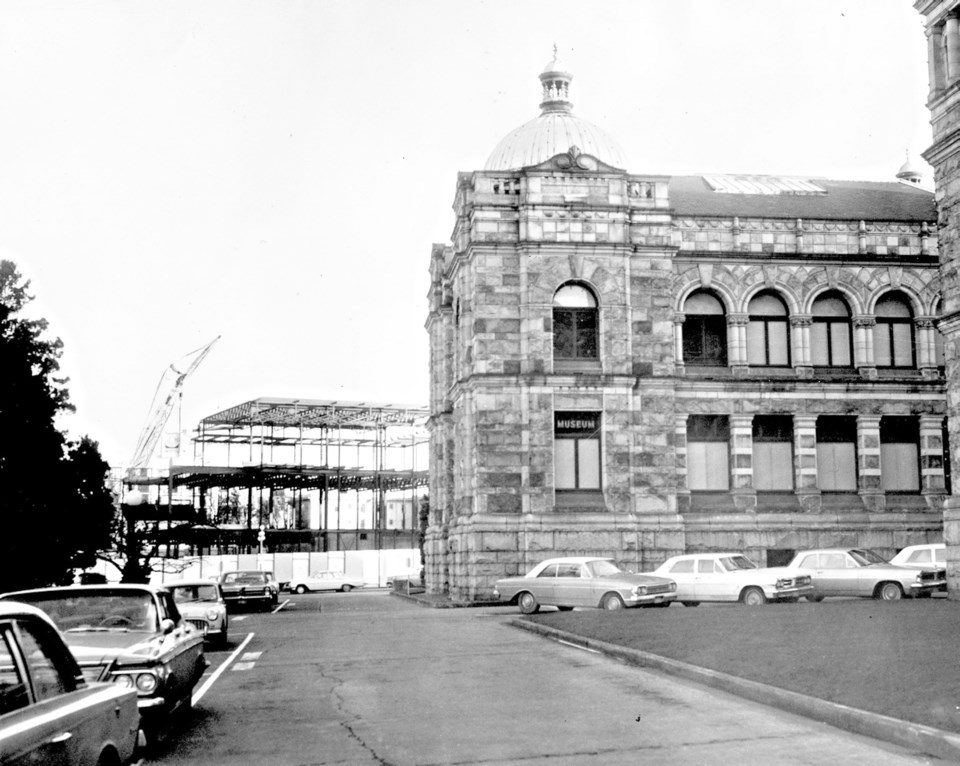Before the Jack Lohman times, the Royal British Columbia Museum was rarely subject of private conversations of Victorians, far less “the talk of the town.” It lurked in the Inner Harbour area like a big mammoth, venerable, dusty and by definition oblivious to the passage of time. Always somewhat enigmatic, it held large collections but possessed no well-defined collection policy other than documenting the native culture and industrial development of B.C.
Few members of the public were aware of its mandate and policy priorities. A case in point is the crucial historical document, the Douglas Treaties, which was “discovered” after years of quietly collecting dust on a shelf.
The B.C. Archives was probably the most indispensable, best known and therefore the most broadly “shared” section of the museum. This is where serious research was done. A small crowd of loosely connected users, past and present, gravitated around the place. All serious students of British Columbian issues would eventually end up there, as attested by the zillions of footnotes and references found in the large body of books devoted to B.C.
Over the past few years, the museum’s relationship with Victorians (seasoned, new, and potential museum-goers) has changed. The museum’s popularity and public appetite for its programs and services are on the rise, along with the unavoidable controversies that new initiatives tend to generate.
On the whole, the museum is moving closer to establishing itself as Victoria’s leading, trend-setting, cultural institution. Today no one would be surprised to hear a neighbour discuss, say, the winners of the latest National Geographic photo competition, which is shown at the museum each year.
We are overjoyed to see our two-and-a-half year old grandson Aleksander see his regular museum visits as a routine family event — despite the fact that he is still afraid of one of the fierce-looking mammoths. When his other set of grandparents come to town, he finds it natural to take them there.
The rejuvenation we are witnessing is due to several factors. One is the generally more welcoming attitude of the museum, another its greatly improved information. Rearrangement and redecoration of some exhibit spaces and public spaces in the building (such as the entrance hall) have helped immensely. We cannot wait for the overhaul of the entire museum to be completed, when funding is finally available.
Educational and other programs come now in larger numbers and in quick succession. No need to wait ages for the next event! This quicker pace helps make spontaneous interaction between the museum and visitors more likely to occur. These mostly brand-new and well-executed programs target the general public as well as specific age and interest groups. Not unexpectedly, new programs attract many new visitors.
Finally, the exhibits. Victorians have been flocking to a series of large, visually breathtaking, and content-rich exhibits (“there is a lot of meat on this bone” a friend said about one) that meet the highest international standards. Not surprisingly, they increased the level of expectations, instantly creating a demand for more. The exhibits demonstrate the excellent skills and professionalism of the museum crew as well as the vision and depth of imagination of the exhibit designers.
There is a clear link between these highly successful productions and the recent massive exposure of the museum to international contacts and new technologies.
Another intriguing feature of these exhibits is how they address local topics while simultaneously embracing the universal perspective. This has been achieved through, among other means, by using international artifacts (e.g. Colombian gold, the mammoth from Siberia), international references and international comparisons (gold rushes elsewhere in the world) in the context of locally relevant narratives. This helps bestow local events with a touch of universality, allowing visitors to take a deep breath and feel part of the broader community.
The concepts of education, knowledge sharing and access are essential to understanding the new vision of what museums are for. Museums build collections which in turn become learning tools. People cannot learn from collections unless they have access to them.
Improving access to highlight the collections of the museum (in both physical, intellectual and digital sense) must remain a priority. This may include loans of artifacts, traveling exhibits of various sizes, electronic data transfer, pre-recorded educational programs and countless other strategies for sharing.
Our small (if metropolitan!) museum — Museum of Architectural Heritage — is currently being set up at Wentworth Villa. It is not a typical “small museum” in a remote location such as those the Royal B.C. Museum is registering on a province-wide scale. Our field of interest — heritage residences of Victoria and the surrounding region — has no equivalent in the Royal B.C. Museum’s mandate. Yet, we too have been recipients of generous help and support from a rejuvenated Big Mammoth eager to make a little mouse happy.
On this occasion of its 130th birthday, we wish to thank RBCM’s leaders for their encouragement, advice, and hours of patient consultations. We are especially grateful for help training our staff in the tricky art of exhibit building and for Frederike Verspoor’s help with the archives.
Magda and Stefan Opalski have created the Museum of Architectural Heritage at Wentworth Villa on Fort Street.
